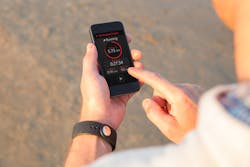Survey: 87 Percent of Consumers Have Adopted One Digital Health Tool
Digital health adoption continues to increase, with 87 percent of consumers saying they have adopted at least one digital health tool, compared to 80 percent in 2015, according to results from San Francisco-based Rock Health’s third national consumer survey on digital health adoption and sentiments.
Rock Health surveyed 4,000 U.S. adults to shed light on how consumers are engaging with technology-driven healthcare innovation. 2017 was the third year Rock Health deployed this survey, providing a three-year trend data for the first time.
Based on the survey data from 2015 to 2017, there is a clear upward trend of consumers taking control of their healthcare via the use of digital tools like telemedicine, wearables, and online provider reviews, according to Rock Health’s report on the survey data.
But the needle has not moved equally across every subgroup of the population—nor across every type of digital health solution, the report states. “The data tell us that some subgroups prefer traditional healthcare channels; that patient demographics influence readiness to pay out of pocket for expanded services; and that those with chronic conditions (often with the greatest potential to benefit from digital health) are selective in their uptake of digital health,” the report authors—Megan Zweig, Jen Shen and Lou Jug, wrote. “So while digital health solutions promise impactful, even life-altering outcomes for patients, consumers are still transitioning to testing out—and sustainably integrating—these solutions into their lives.”
Looking at adoption rates of various digital health solutions, adoption of online health information grew from 72 percent in 2016 to 79 percent in 2017 and adoption of online provider reviews grew to 58 percent in 2017 from 51 percent in 2016. However, only a quarter of consumers have adopted mobile tracking and the same percentage have adopted wearables.
Rock Health’s report on its third national consumer survey on digital health adoption and sentiments found that chronically ill seniors represent the greatest opportunity to improve health—though they are the least likely to use digital health tools. Digital health adoption is significantly higher among young, high-income adults compared to other consumer segments.
While aging adults have the second highest adoption of digital health technologies, the “worried well” segment—aged 18 to 35 with income greater than $75,000—is more likely to use digital tracking tools and wearables by a margin of more than 20 percentage points.
Not surprisingly, chronically ill seniors have the greatest demand for healthcare services—86 percent visited a doctor at least twice in the past year and 97 percent are managing at least one prescription. Yet they are the least likely to leverage digital health technologies, with extremely low rates of live video telemedicine use, digital health goal tracking, and wearable use.
The survey also found that respondents with a self-reported health condition are more likely to track health goals—though most do not use digital apps to do so. Those experiencing health challenges actively track their health, but digital solutions don’t consistently reach these high-need populations. For instance, respondents taking medication and those with high blood pressure are likelier than not to track a related health goal; but a minority of these groups use a digital solution to do so. Of those respondents tracking their blood pressure, only 11 percent do so with a digital app/journal.
However, respondents who self-identified as obese and who track diet or physical activity buck this trend. This subgroup has adopted digital tracking systems at a somewhat higher rate (29 percent use a digital app to track food/diet and 56 percent use a digital app to track physical exercise), compared to the average for all respondents, according to the report.
The Rock Health survey also found challenges to long-term growth for wearables. Among the 24 percent of respondents (974) that own a wearable device or smart watch, over a quarter (260) reported that they no longer use the wearable. As discontinued use threatens the lasting utility of wearables, innovators must offer sustained value to customers or face the fate of other expendable gadgets, the Rock Health researchers noted.
“Interestingly, the top two reasons for discontinued wearable use are contradictory: nearly 30 percent of users discontinued use after achieving their intended goal, while 20 percent stopped use because the wearable was ineffective in helping them achieve their goal,” the researchers wrote. Companies must figure out how to deliver long-term value to ensure sustainable customer engagement, even if users hit health goals along the way.
Fifty-eight percent of respondents have, at some point in their lifetime, searched for an online review of a healthcare provider, according to the report. This marks an increase from 50 percent in 2015, with the boost largely coming from increases in searches for pharmacies and hospitals. A significant group of respondents (ranging from 27 percent to 40 percent) report taking action based on provider online reviews.
Looking at data sharing and security, respondent willingness to share health data with an entity is correlated with confidence in that entity’s data security, the survey found.
Though most respondents are willing to share health data with their physician, there is a significant drop-off in willingness to share with other stakeholders. Fifty-eight percent of respondents are willing to share with health insurance companies and 52 percent with pharmacies.
Respondents’ willingness to share health data with an entity is nearly perfectly correlated with respondents’ confidence in the data security of that entity, the survey found. Of note, respondent confidence in data security of tech companies declined from 31 percent in 2016 to 24 percent in 2017, and the researchers note that may decline further if press about major data breaches continues.


